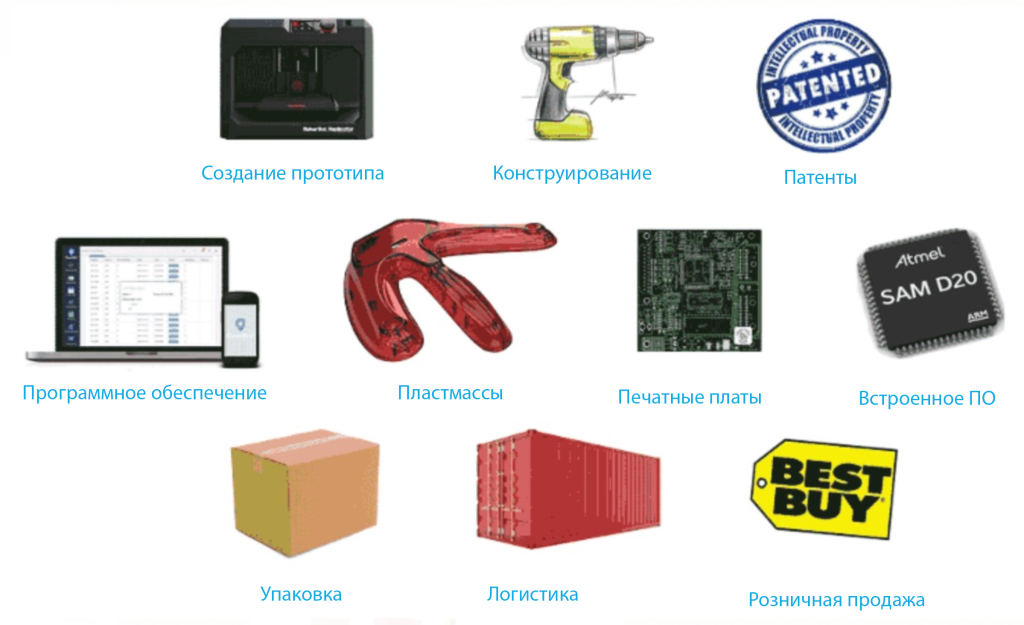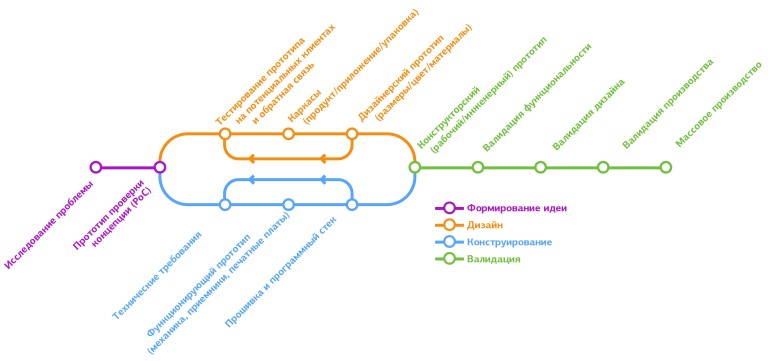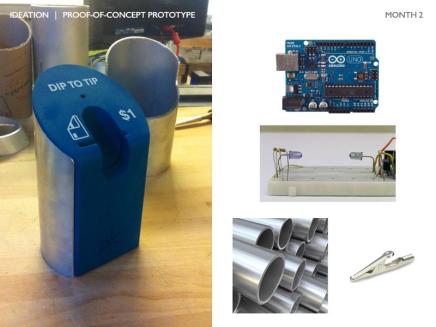Product Development Visual Aid: Creating an Idea

This is a translation of the first part of a four-part series on the development and production of physical products. Author, source: Ben Einstein .
Often the difference between a company that brings billions and a bankrupt company is the ability to create a product that customers will love . But taking into account the cost and time costs in the industrial sector, startups by and large have only one chance to bring goods to the market. They do not have the opportunity to engage in iterative development or allow themselves to release an unfinished product, unlike software startups.
But if creating a really good product is so important, why do most industrial startups neglect to build the right processes when developing a product?
This series of articles will talk about what quality processes for developing physical products can be.

Fig. 1. Typical software development process
Yes, processes are important!
Startups seem to have an allergic reaction to everything related to order. However, most software startups support the implementation of Lean Startup , a concept popularized by Eric Rhys.
This “create-evaluate-learn” cycle is rooted in the culture of software startups, but is not exhaustive for grocery ones. Most of them mean by the product development process something similar:

Fig. 2. Typical physical product development process
Most startups believe that the “our deadlines are on track” approach is faster because it is less costly, but this is far from the case.

Fig. 3. The process of developing hardware products is more complicated than software.
The development of physical products requires more detailed planning than software development. This is due to the huge number of operations that must be performed before launching the product on the market. Most of them have long lead times and high cost of error. A tiny design flaw or a defective part that has passed quality control can lead to your bankruptcy.
The processes
The process that we use in our company BOLT is a combination of rigid processes of manufacturing companies and light processes used by professional designers. It is divided into 4 main stages: idea formation, design, construction and validation.

Fig. 4. Full Product Development Cycle
To illustrate, we will follow the development of the DipJar product using this methodology.

Fig. 5. The first version of DipJar
DipJar is a young company with a simple product for collecting donations and tips from a credit card. DipJar customers pay a fixed amount each month, and the company receives a small percentage of each transaction.
Ryder Kessler and Jordan Bar Am founded the company in New York and raised relatively small investments. In doing so, they successfully shipped many products to customers and showed good product / market compliance. Most of their quick successes are directly related to the focus on iterative development and consumer interests in product development.
PART 1: FORMING IDEAS

Fig. 6. The first stage of product development.
Formation of an idea begins with a clear definition of the problem that the product solves (problem research) and ends with a proof-of-concept prototype. Having allocated enough time to this stage, you can lay a solid foundation for further product development.

Fig. 7. Problem research
Each illustration shows where we are regarding product development (top left) and elapsed time (top right).
Very often, founding engineers immediately start creating a product without identifying the problem they are working on. Understand the problem through a survey of future customers.
When communicating with potential customers:
- Do not try to direct the conversation in any direction. Let communication develop naturally.
- Do not talk about your product or solution.
- Record in detail what you heard in writing or on the recorder to create a database.
- Create at least three images of the target audience (customer personas).
- Pay attention not only to what people say, but also to how they say it.

Fig. 8. Find your moment of insight
Almost every company starts from the moment of “insight” - a story that connects the life experience of the founders of the company with the problem that they solve. For DipJar, such a moment occurred in a coffee shop. As a student, Ryder often visited Starbucks and made friends with a barista. Once, a day in a coffee shop turned out to be especially crowded, which they were not happy about. “At least you get more tips,” Ryder said. But here's the answer he received: “In fact, no one leaves them anymore because of credit cards. It would be better if no one came. ”
Communicating more and more with people, Ryder realized that not only the barista was suffering due to a decrease in cash turnover. He spoke with street musicians, hairdressers, and charities (including the Salvation Army and the Children's Miracle Network, who were among the first to buy DipJar).

Fig. 9. Think about the customer portrait.
Such communication serves as the basis for creating customer portraits (customer personas), generalized, invented images of your ideal users. Frequent communication will provide you with data useful for use in product development.

Fig. 10. The portrait in the figure on the right is better, since it shows the depth of the analysis of the problem.
Usually a good study of the problem in completing this checklist:
- If these are B2B clients: you know what people in the company make decisions, how they purchase products, such as yours, and why the problem you want to solve is the “top 3” problem in their business.
- If it’s B2C: you know with which brands they identify with, in which “marketing territory” they live, you understand their habits.
- You have learned how much they are willing to pay for your product.
- You have determined the size of the target audience.
- If you plan to attract venture capital, you can show how these figures will bring 100 million profit in 5 years.
- If you have solved all these problems, you are ready to start searching for a solution to the problem.
Concept Verification Prototype (PoC, Proof-of-Concept)

Fig. 11. The concept proof prototype Proof of Concept
The essence of the concept proof prototypes is to confirm the main hypotheses that your research into the problem has revealed. In the case of DipJar, the team had to answer the following questions:
- Can people understand in 5 seconds while they are paying at the checkout how to use DipJar?
- Is cash collection also important?
- Do store owners / employees agree to place DipJar at the checkout?

Fig. 12. First Product Prototypes
These questions are critical to assessing the viability of DipJar as a business. The team quickly created several prototypes to test these hypotheses. Three prototypes (pictured above) were created in a few days from finished parts (Arduino, infrared sensors, a piece of aluminum pipe and a plastic part painted with a spray can)
Despite the fact that the main goal of DipJar is to write off money from a bank card, the team did not have time to implement this functionality (and it was not important for testing working hypotheses). Therefore, these prototypes did not even have a card reader. They simply had sensors counting how many times people inserted a bank card.

Fig. 13. Prototyping
The team took the prototypes to several target customers and left them for one day. And then I took them back to evaluate the effectiveness.
Assessment findings:
- People immediately understood what DipJar was and how to use it;
- In most places, cash was collected in existing containers - therefore, the cash collection section was abandoned at the prototype stage;
- Owners and workers were not opposed to allocating a little space at the box office to get more tips.
Any prototyping process is iterative . A few tips to make it more efficient:
- Before you design something, generate a lot of ideas and choose the best ones to create a prototype. For this, some people prefer to use formal approaches: mental maps, brainstorming, etc. In my experience, they are inferior in effectiveness to informal ones: communicating with people, prototyping, and searching for similar technical solutions.
- Focus on hypothesis testing.
- Give priority to speed, not quality (this is difficult for engineers, but at this step, speed is much more important).
- Use the finished parts, not create them with a sketch .
Now you have a good understanding of the problem, and you know how to solve it. Time to optimize your product for use by customers.
This is a translation by the Fablab fablab team , the first part of a four-part series on the development and production of physical products. Author, source: Ben Einstein . Read the translation of the second part.
